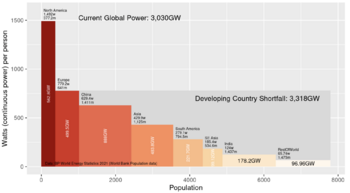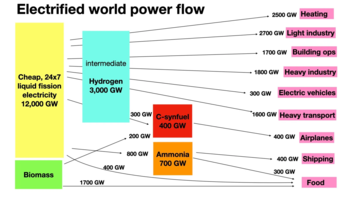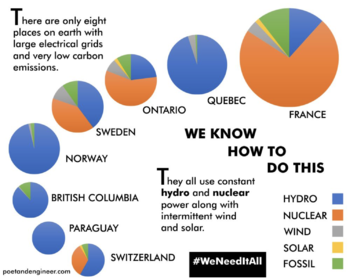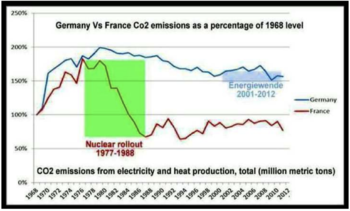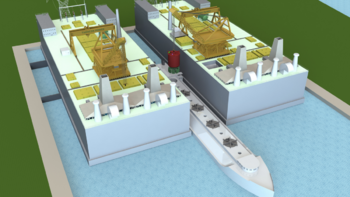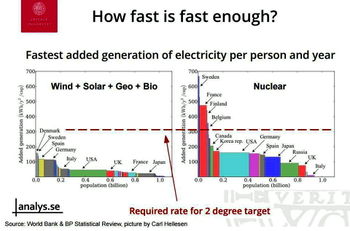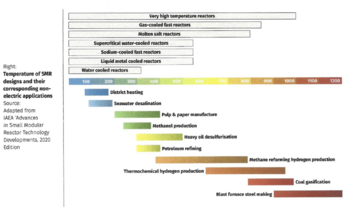Energy policy and global warming: Difference between revisions
Jump to navigation
Jump to search

(change lead paragraph) |
(update figures) |
||
| Line 1: | Line 1: | ||
{{subpages}} | {{subpages}} | ||
{{seealso|Nuclear_power_reconsidered}} | {{seealso|Nuclear_power_reconsidered}} | ||
{{Image|WorldElectricPower2021.png|right|350px|World electric power consumption in 2021 | {{Image|WorldElectricPower2021.png|right|350px|Fig.1 World electric power consumption in 2021 was 3030 GW. This may soon double, including many coal plants in the developing world.}} | ||
{{Image|Electrified World Power Flow.png|right|350px|Electric power generation is only a third of our CO2 problem. A zero-carbon future should include industry and transportation.}} | {{Image|Electrified World Power Flow.png|right|350px|Fig.2 Electric power generation is only a third of our CO2 problem. A zero-carbon future should include process heat for industry and fuels for transportation.}} | ||
{{Image|Large grids low carbon.png| | {{Image|Large grids low carbon.png|left|350px|Fig.3 Success in reducing CO2 requires abundant, clean, reliable power.}} | ||
{{Image|Electrify1Basics.022.png| | {{Image|Electrify1Basics.022.png|right|350px|Fig.4 Wind and solar as the only solution will require unrealistic commitments of land and resources and a new storage technology far less expensive than today's batteries.}} | ||
{{Image|Germany France CO2.png|right|350px|Wind and solar alone are not enough.}} | {{Image|Germany France CO2.png|right|350px|Fig.5 Wind and solar alone are not enough.}} | ||
{{Image|ThorCon Plant.png|left|350px|Two ThorCons will generate 1 GW day or night. The can ship takes away spent fuel and used reactors for recycling.}} | {{Image|ThorCon Plant.png|left|350px|Fig.6 Two ThorCons will generate 1 GW day or night. The can ship takes away spent fuel and used reactors for recycling.}} | ||
{{Image|Countries CO2 targets.jpg|left|350px|Time is short, and build rate is critical to meet our goals.}} | {{Image|Countries CO2 targets.jpg|left|350px|Fig.7 Time is short, and build rate is critical to meet our goals.}} | ||
{{Image|Low-carbon-share-energy.png|left|350px|Few countries are now on track.}} | {{Image|Low-carbon-share-energy.png|left|350px|Fig.8 Few countries are now on track.}} | ||
{{Image|SMR temperature.png|left|350px|Decarbonizing industry will require vast amounts of process heat, either directly from a nuclear reactor, or using hydrogen as an intermediary.}} | {{Image|SMR temperature.png|left|350px|Fig.9 Decarbonizing industry will require vast amounts of process heat, either directly from a nuclear reactor, or using hydrogen as an intermediary.}} | ||
National energy policies have had a profound effect on success in reducing CO2 emissions. Some countries have made substantial progress in meeting the goals they have agreed to. Very few are moving fast enough to limit global warming to 2 degrees C. This article is a brief review of the options for decarbonizing our world. | National energy policies have had a profound effect on success in reducing CO2 emissions. Some countries have made substantial progress in meeting the goals they have agreed to. Very few are moving fast enough to limit global warming to 2 degrees C. This article is a brief review of the options for decarbonizing our world. | ||
==Further Reading== | ==Further Reading== | ||
Revision as of 12:42, 29 May 2022
- See also: Nuclear_power_reconsidered
File:Low-carbon-share-energy.png
Fig.8 Few countries are now on track.
National energy policies have had a profound effect on success in reducing CO2 emissions. Some countries have made substantial progress in meeting the goals they have agreed to. Very few are moving fast enough to limit global warming to 2 degrees C. This article is a brief review of the options for decarbonizing our world.
Further Reading
Electrifying Our World Robert Hargraves' excellent overview of energy, the growth human civilization, and possible solutions to the current climate crisis.
Our World in Data has a section on Energy and Environment with nice interactive graphics.
World Nuclear Information Library a well-organized authoritative collection of information on nuclear power.
